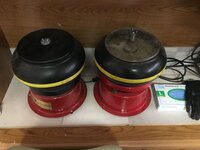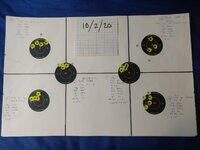Gold Supporter
- Messages
- 3,001
- Reactions
- 6,982
Your machine will definitely work dry. so will an old rock polisher, or maybe a shoebox filled with walnuts rouge and brass strapped to your pan head Harley or old Triumph kidney buster on the next road trip.Wood lathe HAHA thats awesome!
I have a Frankford Arsenal platinum i think its called. I guess i could put dry media in it..?
The though of using the pins dry did cross my mind. Or more pass through.
I prefer ground walnut shells salted with rouge as dry media for either brass (sans primer), or already loaded (since there is a propensity for the media to catch in primer holes requiring inspection). If I need a mirror shine I use corncobs. I'd pass on the dry pins. the point of the wet is to carry off the stuff you are trying to clean. unless the brass is already clean and you are looking to abrade, texture or polish depending on the dry grit type and size, Pins won't clean very well dry with nothing to carry off the residue so still need washing, or at least rinsing, of both the brass and media afterword to remove whatever your trying to clean. You may be able air hose off the dust I suppose. The walnut shells will absorb the goo and / or stick to the shells and you just throw it away after a few uses ( depending on how dirty the brass is maybe five or six times) when it becomes loaded. If you take your time and look around some, walnut shells can be had for cheap. Keep your bags sealed so it will stay bone dry. Powdered rouge, my preference, gives a sweet shine albeit a slow clean. Works really well for best bright shine with soft corncob. Many other things like carbide, silicon, aluminum or coarser iron oxides etc. will work as a media fortifier, some faster though some not as forgiving.
To over simplify, Rouge is finely ground rust so some thought as where residue may be left without harm is needed but in fifty years I have never found ammo with little rouge here or there an issue..
For best economy, buy your media and polish compound separately looking for best price.














